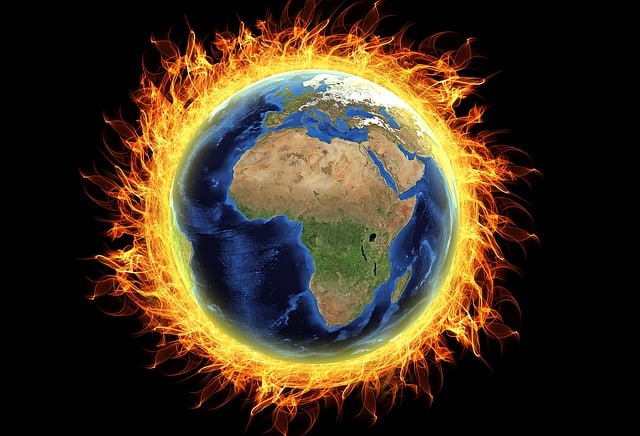For millions of years, the earth’s climate has naturally fluctuated, changing up from warmer periods to ice ages. However, within the past century, the earth’s temperature has increased unusually fast; 1.2 to 1.5 degrees Fahrenheit to be exact. According to research studies, human activities are hugely contributing to this unusual spike in temperatures; a phenomenon commonly referred to as global warming.
The proliferation of fossil fuels such as coal, oil and natural gas triggered by the onset of industrial revolution are the main contributors to global warming. Power plants, factories, and cars have been burning these fossils fuels since the industrial age, releasing massive amounts of greenhouse gasses. Greenhouse gasses contribute to a natural phenomenon called greenhouse effect.
Greenhouse Effect
To understand global warming, it would be beneficial to know what greenhouse effect is. The atmosphere is composed of a few gasses such as carbon dioxide, nitrous oxide, and methane. The collective name for these gasses is greenhouse gasses. If they are in the right amount, these greenhouse gasses are good.
Greenhouse gasses naturally form a circular layer wrapping around the earth. When sun rays strike the surface of the earth, some are absorbed by the earth. But a majority of them bounce back to the atmosphere. The reflected sun rays go all the way to the upper atmosphere.
In the upper atmosphere, the greenhouse gasses absorb vast quantities of heat from the reflected sun rays. Some of the heat finds way into space. The heat absorbed by greenhouse gasses meander in every direction. The absorbed heat helps in keeping the earth warm. If the heat emanating from the sun is not absorbed by these greenhouse gasses, the earth will freeze.
This point to the fact that these gasses are essential for the survival of every species living on earth such as animals, plants, and humans. This absorption of the sun’s heat by greenhouse gasses to keep the earth warm is referred to as greenhouse effect. The greenhouse effect ensures that humans live happily on earth.
Global Warming
Now that we have understood the greenhouse effect phenomenon, let’s delve into global warming. We have seen that there is a natural balance of greenhouse gasses in the atmosphere. However, the sad fact is that humans are interfering with the balance of greenhouse gasses every day. How? By beefing up the levels of greenhouse gasses through smoke emanating from factories and vehicles.
This smoke contains a whole host of greenhouse gasses such as carbon dioxide and methane. Happily, the abundance of trees sucks up most of the carbon dioxide. Sadly, humans are cutting trees at an alarming rate. This means that there is less plant life to suck up the excess greenhouse gasses, but more cars and factories that crank up the amount of gasses. When the level of gasses caused by cars and factories increase in the atmosphere, the layer of greenhouse gasses surrounding the earth increases in thickness.
This means that when the sun rays are reflected by the earth, they come into contact with the thick layer of greenhouse gasses surrounding the earth and all of the heat is trapped. No amount of heat goes out to the outer space. This leads to increase in temperatures, and the earth gradually starts to become warmer. This phenomenon is known as global warming.
Various Global Warming Solutions
There are hundreds of solutions you can adopt to minimize global warming. Let’s check out the most essential ones:
- Change up to renewable sources of energy
Multiple research studies have substantiated that burning fossils fuels like oil, coal and natural gas cranks up the level of greenhouse gasses in the atmosphere. Greenhouse gasses such as carbon dioxide and methane are the greatest contributors to global warming and greenhouse effect. A shift to renewable sources of energy such as wind, solar and hydropower will help bring down demand for fossils fuels and eventually lower the level of greenhouse gasses emitted into the atmosphere.
- Buy recycled products
You can help minimize cutting down of trees that help to balance the amount of greenhouse gasses in the atmosphere by buying recycled paper products. Also, order or buy products that require less packaging to cut down on the amount of waste that would find way to landfills causing massive environmental pollution. If there is no recycling plant in your area, make a point to start one. There is a wide range of materials in your neighborhood that need recycling such as paper, plastic, steel, aluminum just to name a few.
- Less driving
Minimal driving is tantamount to less emission. Less driving also means less out-of-pocket costs. Choosing healthy activities such as walking and riding a bicycle is a great way to cut back on atmospheric emissions. When going to work, choose public transportation like rails or community mass transport system. Carbon footprints can also be brought down by taking vacations. These acts serve to minimize the number of cars on the road, hence, reducing the possibility of global warming.
When you choose to drive, ensure the car is working efficiently. For instance, making sure that your car tire is at always properly inflated can enhance your gas mileage by over 3%. Each gallon of gas you save keeps your purse string closed and reduces the amount of greenhouse gasses in the atmosphere.
- Keep devices and appliances switched off
When not using devices and appliances such as computers, laptops, ovens, television and so on, make sure they are switched off. This act reduces the amount of energy expenditure by more than 40 percent. This is, without any doubt, good for the environment.
- Always go for energy-efficient products
When the time comes for you to buy a car, select one that has immaculate gas mileage. Manufacturers these days are responding in kind by manufacturing cars and home appliances that are energy efficient. LED lights are increasingly coming with natural looking light and use surprisingly less energy than standard bulbs.
- Develop a habit of planting a tree
Trees play a critical role in maintaining greenhouse gas balance. If you have the resources to plant a tree, you better get down and start digging to save the planet. Abundance of trees would effectively counteract the emissions caused by factories, cars, and other human activities. According to research findings, one tree can absorb more than one ton of carbon dioxide within its lifetime.
- Save energy by using less hot water
Save energy by ensuring your water heater is set at 120 degrees. If it has served you for over 5 years, cover it with an insulating blanket. Invest in low-flow showerheads. This will save on hot water use including 350 pounds of CO2 emission annually. Utilize cold and warm water to clean your clothes. These significant lifestyle changes could save over 500 pounds of carbon emission each year.
- Be an energy conservation ambassador
Teach your friends, family, and neighbors about recycling and energy conservation. Take time to encourage public officials to initiate policies and programs that promote clean environment.
- Make a point to get an energy report from your utility company
Most utility companies these days offer free energy audits that point to the homeowner specific sectors of the house that are not energy efficient. This report can serve as a pillar for energy conservation practices.
- Always use the off switch
At all times switch off electricity when you leave your room or home. When in a room, use just the required amount of light you need. Also, the tap should not be left running when not in use. When washing your car, cleaning the dog, or even brushing your teeth, turn off the tap until you are ready to rinse.
- Use public transportation
Pollution from vehicles account for major portion of carbon emissions. Usage of public transportation, car pooling and low carbon fuels not only reduce pollution but also reduce vehicular traffic on the road. In the long run, public transportation appear more cost friendly and doesn’t pinch the pocket.
- Stop deforestation
Less trees means less absorption of greenhouse gases which are in itself responsible for more global warming. We can fight global warming by reducing deforestation and forest degradation. Managing forests and agriculture therefore should be the top priority to reduce carbon emissions.
- Spreading word
Word of mouth is the best way to create awareness among the people to stop carbon emissions. Presentations, meetings and discussions over global warming provide information about viable solutions to global warming, and reinforcing the economic benefits available throughout the Midwest from the development of renewable energy and energy efficiency.







